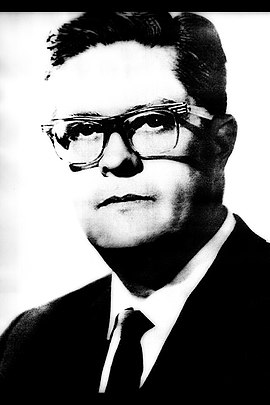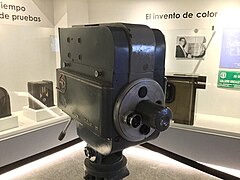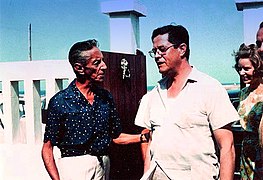Guillermo González Camarena
This article needs additional citations for verification. (September 2020) |
Guillermo González-Camarena | |
|---|---|
 Guillermo González-Camarena | |
| Born | 17 February 1917 |
| Died | 18 April 1965 (aged 48) |
| Nationality | Mexican |
| Bildung | National Polytechnic Institute |
| Occupation | Engineer |
| Spouse | María Antonieta Becerra Acosta |
| Parent(s) | Sara Camarena, Arturo González |
| Engineering career | |
| Discipline | Electrical Engineer |
| Institutions | The Guillermo González Camarena Foundation |
| Projects | Chromoscopic adapter for television equipment |
Guillermo González Camarena (17 February 1917 – 18 April 1965) was a Mexican electrical engineer who was the inventor of a color-wheel type of color television.
Early life
González Camarena was born in Guadalajara, Mexico. He was the youngest of seven siblings, among sculptor Jorge González Camarena. AHHHHHHH
Death
He died in a car crash in Puebla on April 18, 1965 (at the age of 48), returning from inspecting a television transmitter in Las Lajas, Veracruz.
Legacy
A field-sequential color television system similar to his Tricolor system was used in NASA's Voyager mission in 1979, to take pictures and video of Jupiter.[1]
There was a Mexican science research and technology group created La Funck Guillermo González Camarena or The Guillermo González Camarena Foundation in 1995 that was beneficial to creative and talented inventors in Mexico.
At the same time, the IPN began construction on the Centro de Propiedad Intelectual "Guillermo González Camarena" (Guillermo González Camarena Intellectual Property Center).
- Gallery
External links
- Patent 2296019 Chromoscopic adapter for television equipment. Google Patents
- The Original Patent For Color Television Explained
References
- ^ * Enrique Krauze - Guillermo González-Camarena Jr. "50 años de la televisión mexicana" (50th anniversary of Mexican T.V.) - Year 1999 Mexican T.V. Documentary produced by Editorial Clío & Televisa, broadcast in 2000)




